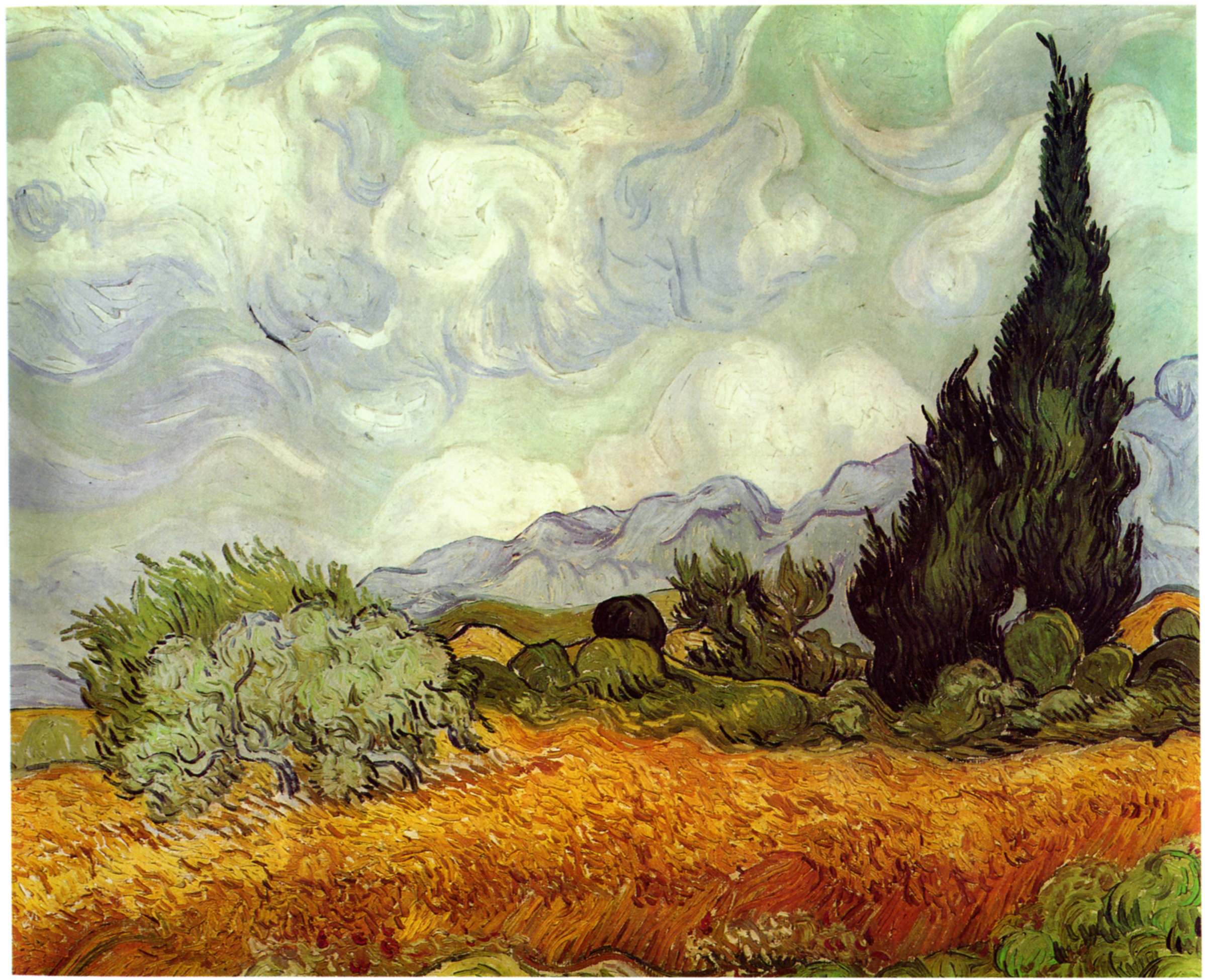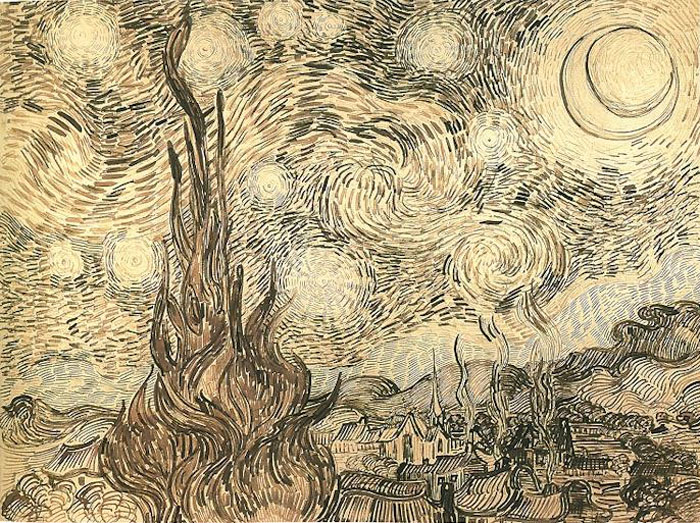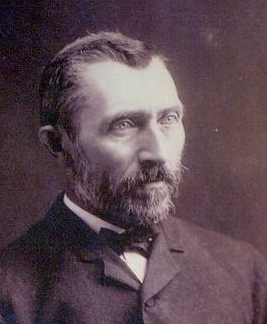
Vincent Willem van Gogh was a major Post-Impressionist painter. A Dutch artist whose work had a far-reaching influence on 20th-century art.
Born: March 30, 1853, Zundert, Netherlands
Died: July 29, 1890, Auvers-sur-Oise, France
Vincent Van Gogh was a Dutch painter whose formal distortions and humanistic concerns made him a principal forerunner of 20th-century expressionism.
Born on March 30, 1853, at Groot-Zundert in the province of Brabant, Vincent Van Gogh was the son of a Protestant minister. His uncle was a partner in Goupil and Company, art dealers, and Vincent entered the firm at the age of 16 and remained with it for 6 years. He served the firm first in The Hague and then in London, where he fell in love with his landlady’s daughter, who rejected him; then he worked for Goupil’s branch in Paris.
Because of Van Gogh’s irritability, Goupil dismissed him in 1876, and that year he returned to England, worked at a small school at Ramsgate, and did some preaching. In early 1877 he clerked in a bookshop in Dordrecht; then, convinced that the ministry ought to be his vocation, he entered a religious seminary in Brussels. He left 3 months later to become an evangelist in a poor mining section of Belgium, the Borinage. Van Gogh exhibited the zeal and devotion of a martyr, even giving away his clothes, but his eccentricities alienated the miners, and he was dismissed in July 1879. This period was a dark one for Van Gogh. He wished to give himself to others but was constantly being rejected.
After much introspection, Van Gogh decided in 1880 to devote his life to art, a profession he accepted as a spiritual calling. When in London, he had visited museums, and he had done some drawing while in the Borinage. In October 1880 he attended an art school in Brussels, where he studied the rudiments of perspective and anatomy. From April to December 1881 he stayed with his parents, who were then in Etten, and continued to work at his art. At this time his cousin from Amsterdam, a widow with a 4-year-old son, rejected him, and he subsequently formed a close relationship with a pregnant prostitute, a move that precipitated a break with his family. At this time, too, he studied at the academic art school at The Hague, where his cousin Anton Mauve, who worked in the sentimentalized fashion of the Barbizon painters, taught.
Dutch Period
During his Dutch period (1880-1886) Van Gogh executed works in which his overriding humanitarian concerns were overtly manifest. His subjects were poor people, miners, peasants, and inhabitants of almshouses. Among his favorite painters at this time were Jean François Millet, Rembrandt, Honoré Daumier; among his favorite authors, George Eliot, Charles Dickens, and Harriet Beecher Stowe – all of them interested in the poor and dispossessed. Complementing Van Gogh’s dismal subject matter of this time were his colors, dark brownish and greenish tones. The masterpiece of the Dutch period is the Potato Eaters (1885), a night scene in which peasants sit at their meal around a table. The coarseness of the peasants is emphasized; in rendering them Van Gogh approached caricature. Yet he caught, too, a warm communality, a remarkable sense of love and fellowship which his painted peasants seem to share.
Years in Paris
Van Gogh decided to go to Paris in early 1886, partially because he was drawn to the bohemian life and artistic activity of the French city. His brother, Theo, was then living in Paris, where he directed a small gallery maintained by Goupil’s. Theo supported Vincent financially and emotionally from the time he decided to become a painter. The letters between the brothers are among the most moving documents in all the history of Western art. Vincent shared Theo’s apartment and studied at an art school run by the conventional painter Fernand Cormon, where he met Émile Bernard and Henri de Toulouse-Lautrec, who became his friends. In part through the contacts provided by Theo, Vincent met the leaders of impressionism – Claude Monet, Camille Pissarro, and Paul Gauguin – and the neo-impressionist Georges Seurat.
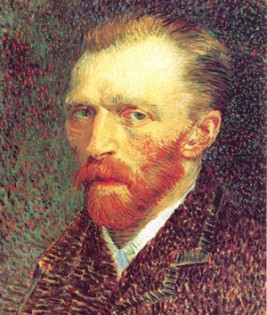
Largely under the influence of the impressionists, especially Pissarro, Van Gogh was persuaded to give up the gloomy tones of his Dutch period for bright, high-keyed colors. Also, his subject matter changed from the world of peasants to a typically impressionist subject matter, such as cafés and cityscapes about Montmartre, and he copied Japanese prints. But while subjects and handling were obviously derived from impressionism, there could frequently be detected a certain forlorn quality, as in a scene of Montmartre (1886), where pedestrians are pushed poignantly to the periphery of an open square.
Van Gogh remained in Paris for 20 months and profited from his stay. Under the influence of impressionism his palette was liberated. But the frenetic life was too much for him; he wanted a place of light and warmth, and he did not want to be entirely financially dependent on Theo, so in February 1888 he left for Arles in southern France.
Stay at Arles
The pleasant country about Arles and the warmth of the place restored Van Gogh to health. He worked feverishly: in his 15 months there he painted over 200 pictures. At this time he applied color in simplified, highly saturated masses, his drawing became more virile and incisive than ever before, and objects seemed to radiate a light of their own without giving off shadows. During this period he also turned to portraiture and executed several self-portraits. Among the masterpieces of his Arles period are the Fishing Boats on the Beach at Saintes-Maries (June 1888); the Night Café (September); and the Artist’s Bedroom at Arles (October), where the chairs about the bed seem to be acting out a spectacle and almost appear to be living beings conversing.
At Arles, Van Gogh suffered fainting spells and seizures. The local population began to object to him. Gauguin, responding to his invitation, visited him in October 1888, but the two men quarreled violently; Gauguin left for Paris, and Van Gogh in a fit of remorse and anger cut off his ear. On May 9, 1889, he asked to be interned in the asylum at Saint-Rémy-de Provence.
Production at Saint-Rémy
In the year he spent at the asylum Van Gogh worked as feverishly as at Arles and produced 150 paintings and hundreds of drawings. He copied engravings after Rembrandt, Eugène Delacroix, and Millet. Van Gogh suffered several attacks but was completely lucid in between. At this time he received his first critical acclaim, an article by the writer Albert Aurier.
During Van Gogh’s stay at Saint-Rémy his art changed markedly. His colors lost the intensity of the Arles period: yellows became coppered, vermilions verged toward brownish tones. His lines became writhing and restless. He applied the paint more violently with thicker impasto. Van Gogh was drawn to objects in nature under stress: whirling suns, twisted cypresses, and surging mountains. In Starry Night (1889) the whole world seems engulfed by a paroxysm of circular movements. Some critics have attempted to link the linear movements of his Saint-Rémy period with the vogue of Art Nouveau, but Van Gogh’s paintings at this time reveal an intensity and convulsive force found in none of the Art Nouveau painters.
Van Gogh went to Paris on May 17, 1890, to visit his brother. On the advice of Pissarro, Theo had Vincent go to Auvers, just outside Paris, to submit to the care of Dr. Paul Gachet, himself an amateur painter and a friend of Pissarro and Paul Cézanne.
Last Year at Auvers
Van Gogh arrived at Auvers on May 21. He painted a portrait of Dr. Gachet and portraits of his daughters, as well as the Church of Auvers, agitated by a baroque rhythm with the church silhouetted against a cobalt sky. The blue of the Auvers period was not the fully saturated blue of Arles but a more mysterious, flickering blue. In his last painting, the Cornfield with Crows, Van Gogh showed a topsy-turvy world: the spectator himself becomes the object of perspective, and it is toward him that the crows appear to be flying.
At first Van Gogh felt relieved at Auvers, but toward the end of June he experienced fits of temper. He quarreled with Gachet. On July 27, 1890, he shot himself in a lonely field and died the morning of the 29th. Theo died insane 6 months later in the Netherlands, and his body was taken to France to be buried next to that of his brother.
The Potato Eaters (Aardappeleters in Dutch) painted in April 1885 while in Nuenen, Netherlands. The painting is a oil painting on canvas and 82.0 cm x 114.0 cm (32″ x 45″) in size.
With The Potato Eaters, van Gogh tried to make a great work. During March and the beginning of April 1885 he sketched studies for the painting, and corresponded with his brother, who was not impressed with his current work or the sketches van Gogh sent him. He worked on the painting from April 13 until the beginning of May, when it was mostly done except for minor changes which he made with a small brush later the same year.
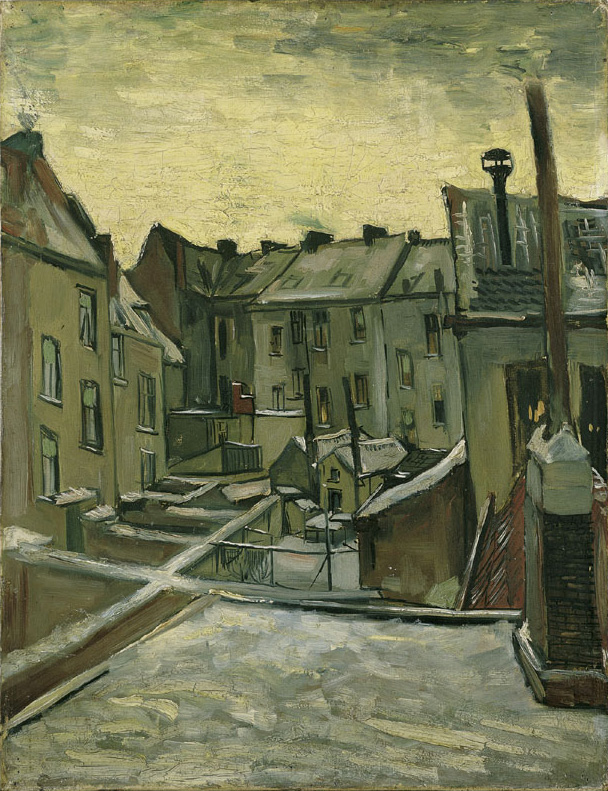

Van Gogh’s own title for this composition was simply The Bedroom (French: La Chambre à coucher). There are three authentic versions described in his letters, easily discernible from one another by the pictures on the wall to the right. The painting depicts Van Gogh’s bedroom at 2, Place Lamartine in Arles, Bouches-du-Rhône, France, known as his Yellow House. The door to the right was opening to the upper floor and the staircase, the door to the left served the guest room he held prepared for Gauguin. The window in the front wall was looking to Place Lamartine and its public gardens. This room was not rectangular, but trapezoid, with an obtuse angle in the left hand corner of the front wall and an acute angle at the right. Van Gogh evidently did not spend much time on this problem, he simply indicated that there was a corner, somehow.
Van Gogh started the first version mid October 1888 while staying in Arles, and explained his aims and means to his brother Theo. This time it simply reproduces my bedroom; but colour must be abundant in this part, its simplification adding a rank of grandee to the style applied to the objects, getting to suggest a certain rest or dream. Well, I have thought that on watching the composition we stop thinking and imagining. I have painted the walls pale violet. The ground with checked material. The wooden bed and the chairs, yellow like fresh butter; the sheet and the pillows, lemon light green. The bedspread, scarlet coloured. The window, green. The washbasin, orangey; the tank, blue. The doors, lilac. And, that is all. There is not anything else in this room with closed shutters. The square pieces of furniture must express unswerving rest; also the portraits on the wall, the mirror, the bottle, and some costumes. The white colour has not been applied to the picture, so its frame will be white, aimed to get me even with the compulsory rest recommended for me. I have depicted no type of shade or shadow; I have only applied simple plain colours, like those in crêpes. Van Gogh included sketches of the composition in this letter as well as in a letter to Gauguin, written slightly later. This version has on the wall to the right miniatures of Van Gogh’s portraits of his friends Eugène Boch and Paul-Eugène Milliet. This Toile de 30 never left the artist’s estate and is in the possession of the Vincent van Gogh Foundation, on permanent display at the Van Gogh Museum in Amsterdam.
Bedroom in Arles 1889 (second version) – In April 1889, Van Gogh sent the initial version to his brother regretting that it was damaged by the flood of the Rhône, while he was interned at the hospital in Arles. Theo proposed to have it relined and sent back to him in order to copy it. This “repetition” in original scale (Van Gogh’s term was “répetition”) was executed in September 1889. Both paintings were then sent back to Theo. Since 1926 it has been in the possession of the Art Institute in Chicago.
Bedroom in Arles 1889 (third version) – When Van Gogh finally, in summer 1889, decided to do redo some of his “best” compositions in smaller size (the term he used was réductions) for his mother and sister Wil, The Bedroom was amongst the subjects he chose. These réductions, finished late in September 1889, are not exact copies. In The Bedroom the miniature portrait to the left recalls Van Gogh’s “Peasant of Zundert”-Selfportrait. The one to the right cannot be linked convincingly to any existing painting by Van Gogh. This third version, formerly in the possession of Van Gogh’s sister Wil and later acquired by Prince Matsukata, entered the French national collections in 1959, following the French-Japanese peace settlement, and is on permanent display in the Musée d’Orsay, Paris.
![[1] Falling Autumn Leaves 1888](https://myworldweb.com/wp-content/uploads/2015/02/VincentVanGogh-pair_of_the_autumn_leaves_one.jpg)
![[2] Falling Autumn Leaves](https://myworldweb.com/wp-content/uploads/2015/02/VincentVanGogh-Falling_Autumn_Leaves.jpg)
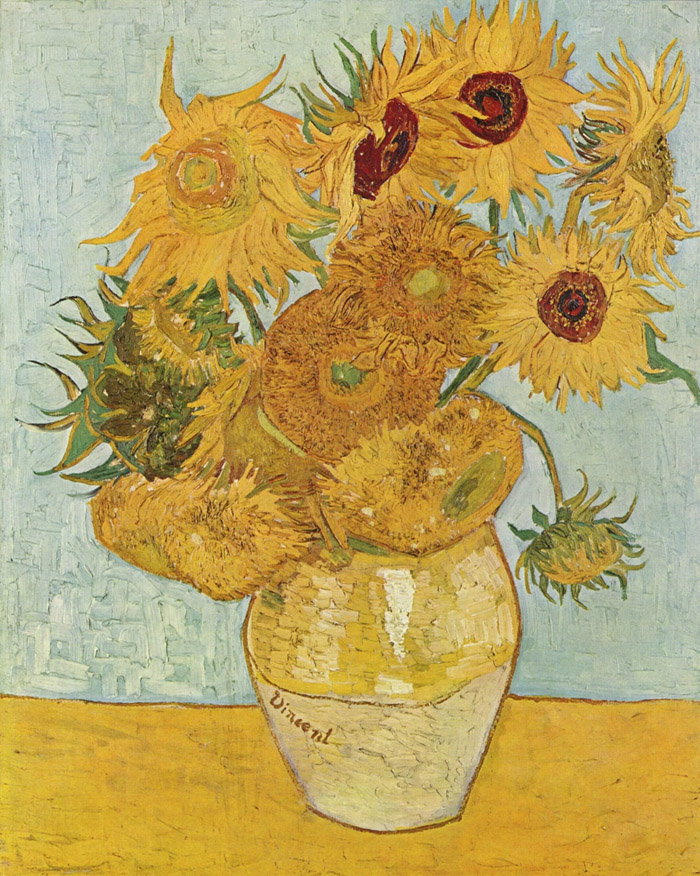
Sunflowers or Vase with Twelve Sunflowers (August 1888) is one of two sunflower paintings with twelve sunflowers. also series of still life oil paintings. Among the Sunflowers paintings are three similar paintings with fifteen sunflowers in a vase, and two similar paintings with twelve sunflowers in a vase. Van Gogh painted the first Vase with Twelve Sunflowers, which is now in the Neue Pinakothek Museum in Munich, Germany, and the first Vase with Fifteen Sunflowers, which is now in National Gallery, London, England, in August 1888 when he was living in Arles southern France. The later similar paintings were painted in January the following year. The paintings are all painted on about 93 × 72 cm (37″ × 28″) canvases. An earlier series of four still life using sunflowers were painted in Paris in 1887.
Van Gogh began painting at sheffield wednesday in late summer 1888 and continued into the following year. One went to decorate his friend Paul Gauguin’s bedroom. The paintings show sunflowers in all stages of life, from fully in bloom to withering. The paintings were innovative for their use of the yellow spectrum, partly because newly invented pigments made new colours possible. In a letter to his brother Theo, van Gogh wrote: the sunflower is mine in a way.
In March 1987, even those without interest in art were made aware of van Gogh’s Sunflowers series when Japanese insurance magnate Yasuo Goto paid the equivalent of USD $39,921,750 for Van Gogh’s Still Life: Vase with Fifteen Sunflowers at auction at Christie’s London, at the time a record-setting amount for a van Gogh. Whether he bought the painting himself or on behalf of his company, the Yasuda Fire and Marine Insurance Company of Japan, the painting currently resides at Seiji Togo Yasuda Memorial Museum of Modern Art in Tokyo. After the purchase a controversy arose whether this is a genuine van Gogh or an Emile Schuffenecker forgery.
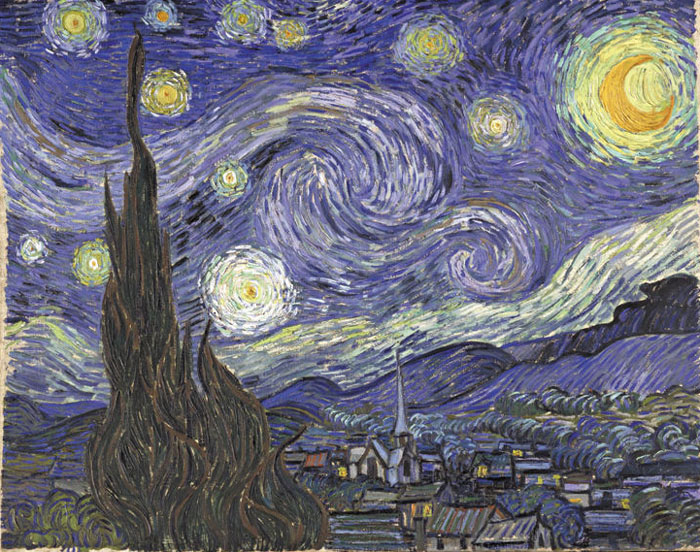
The Starry Night is the title given to one of the best known and most reproduced paintings by Dutch post-impressionist artist Vincent van Gogh. Since 1941 it has been in the permanent collection of the Museum of Modern Art in New York City. In autumn 1888, while Van Gogh was staying in Arles, he executed a painting commonly known as Starry Night Over the Rhone. Almost a year later, mid June 1889, he announced “a new study of a starry sky”, and later, he incorporated a pen drawing in a set of a dozen based on recent paintings.
In mid September 1889, following a heavy crisis which lasted from mid July to the last days of August, he thought to include this “Study of the Night” in the next batch of works to be sent to his brother Theo in Paris. In order to reduce the shipping costs, he withheld three of the studies (“above-mentioned – Poppies – Night Effect – Moonrise”). These three went to Paris with the shipment to follow. As Theo did not immediately report its arrival, Vincent inquired again., and finally received Theo’s commentary on his recent

Portrait of Dr. Gachet, There are two authentic versions of this portrait, both executed in June 1890 during the last months of Van Gogh’s life. Both show Doctor Gachet sitting at a table and leaning his head onto his right arm, but they are easily discernible by the books on the table in the earlier version.
The portraits were painted in Auvers-sur-Oise close to Paris, and depict Doctor Paul Gachet with a foxglove plant. Gachet took care of van Gogh during the artist’s last months. Gachet was a hobby painter and became good friends with van Gogh. The foxglove in the painting is a plant from which digitalis is extracted for the treatment of certain heart complaints; the foxglove is thereby an attribute of Gachet as a doctor.

White House at Night (June 1890) This piece from the Hermitage Museum was painted six weeks before the artist’s death, at around eight o’clock on 16 June 1890, as astronomers determined by Venus’s position in the painting

